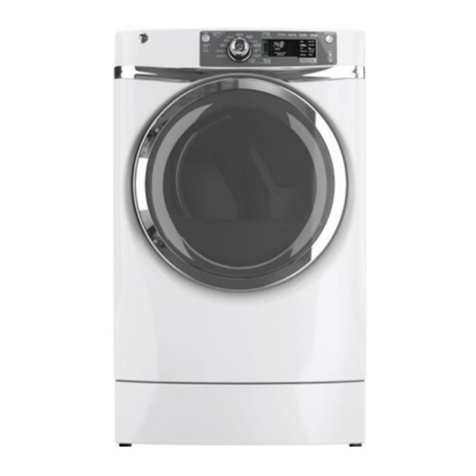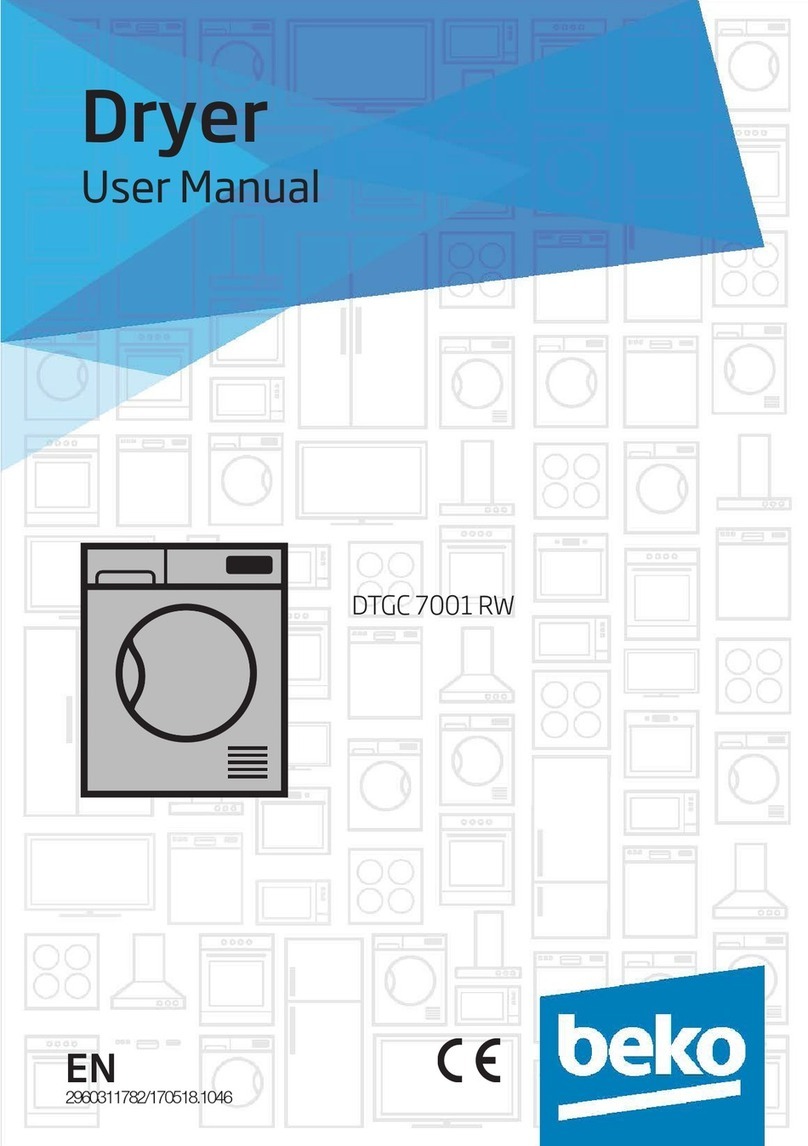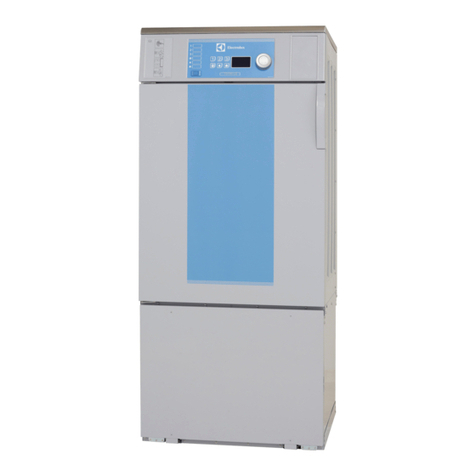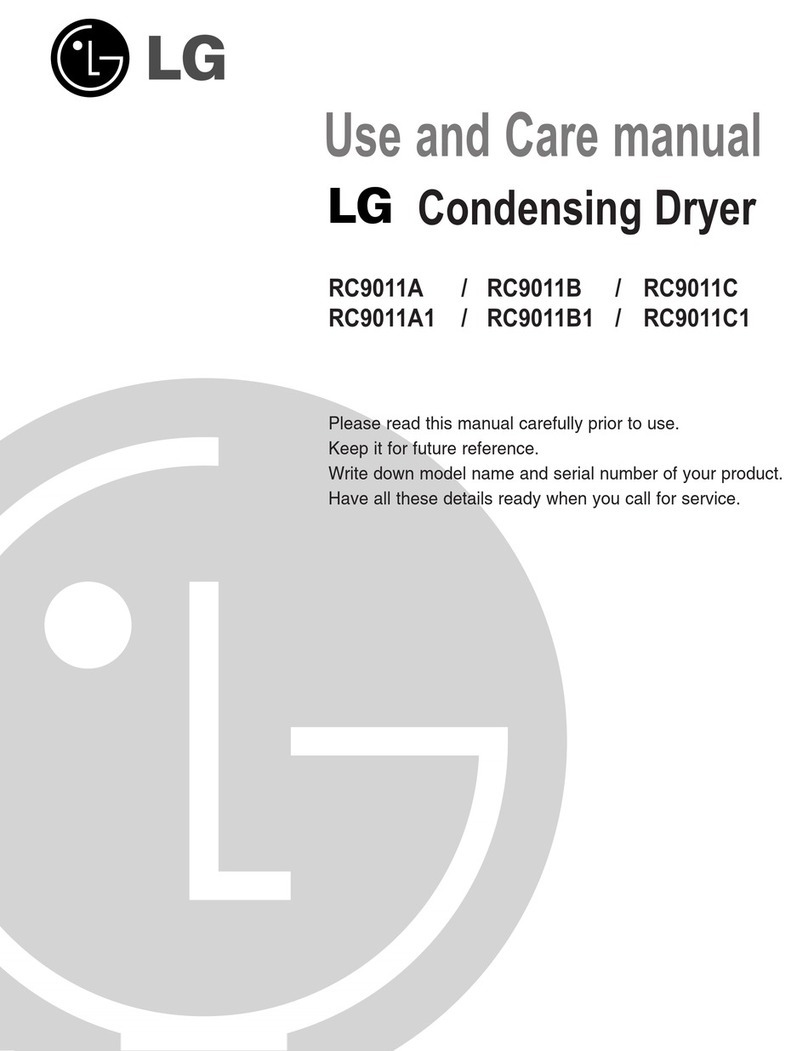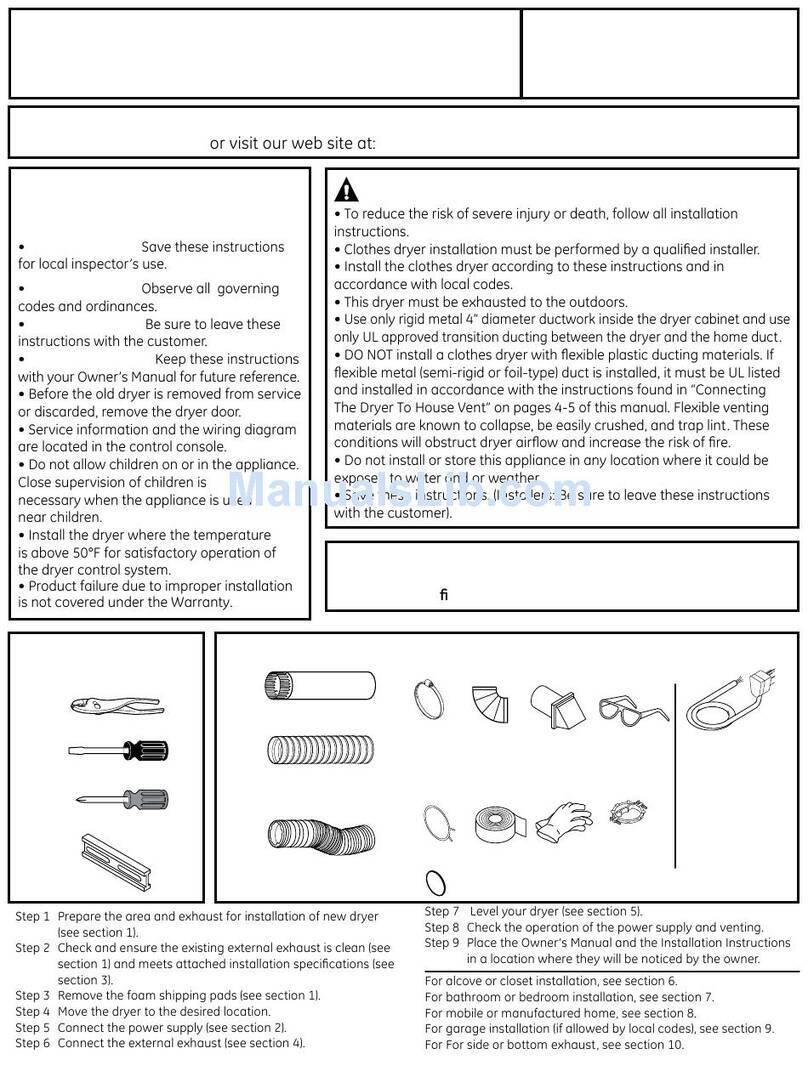General Pneumatics Optima Series Instruction manual

Optima Series
Regenerative Desiccant Dryer System
Models: OP15 through OP500
Installation
Operation
Maintenance
Manual

Warranty Policy
The following clearly defines the General Pneumatics Warranty Policy. General Pneumatics
management is solely responsible for establishing service rates and determining the dispo-
sition of warranty claims. Approval for deviation from this policy must have prior approval of
General Pneumatic management.
Warranty
General Pneumatics products are rigidly inspected throughout the manufacturing process.
Our products are warranted for a period of one year from date of shipment against defective
materials and workmanship when properly installed and operated within design conditions.
All parts proven to be defective within this period will be replaced free of charge, with all ship-
ment and labor charges paid by customer. Claims for damage or lost labor will not be al-
lowed; nor can we guarantee our equipment against corrosion or similar sources of failure
where the operating conditions are beyond our control; nor do we guarantee a minimum
length of service on these products.
THE WARRANTY DESCRIBED ABOVE IS IN LIEU OF ALL WARRANTIES, EXPRESS OR
IMPLIED, INCLUDING THE IMPLIED WARRANTY OF MERCHANTABILITY AND THE IM-
PLIED WARRANTY OF FITNESS FOR A PARTICULAR PURPOSE, WHICH IMPLIED
WARRANTIES ARE EXPRESSLY DISCLAIMED.
THE MANUFACTURER EXPRESSLY DISCLAIMS AND EXCLUDES ANY LIABILITY FOR
CONSEQUENTIAL, INCIDENTAL, INDIRECT, OR PUNITIVE DAMAGES FOR BREACH
OF ANY WARRANTY. THIS LIMITED WARRANTY SHALL CONSTITUTE THE COM-
PLETE AND FINAL AGREEMENT BETWEEN THE MANUFACTURER AND PURCHASER
WITH RESPECT TO ALL WARRANTY OBLIGATIONS OF THE MANUFACTURER AND
PRODUCTS SOLD.
Printing History: 1999, by General Pneumatics
All rights reserved.
General Pneumatics
4647 S.W. 40th Ave.
Ocala, Florida 34474
Document No: X - 977
Revision: D
Released: March, 1999

Contents
Section 1 General Information
1.1 Foreword ............................................................................... 1 - 1
1.2 General System Information .................................................. 1 - 1
1.2.1 Dryer...................................................................................... 1 - 1
1.2.2 Prefilter Assembly.................................................................. 1 - 1
1.2.3 Automatic Drain Valves.......................................................... 1 - 2
1.2.4 Afterfilter Assembly................................................................ 1 - 2
Section 2 Installation
2.1 Receiving and Inspection....................................................... 2 - 1
2.2 EquipmentHandling .............................................................. 2 - 1
2.3 Mechanical Set-Up ................................................................ 2 - 1
2.4 General Piping Information .................................................... 2 - 2
2.5 Purge Exhaust Restrictor....................................................... 2 - 3
2.6 Purge Exhaust Muffler ........................................................... 2 - 3
2.7 ElectricalConnection ............................................................. 2 - 3
2.8 Remote Alarm Connection..................................................... 2 - 5
2.9 Equipment Check .................................................................. 2 - 5
2.10 Instrumentation...................................................................... 2 - 6
Section 3 Operation
3.1 Start-Up ................................................................................. 3 - 1
Dryer Models OP15 through OP200 ...................................... 3 - 1
Dryer Models OP250 and OP300 .......................................... 3 - 2
Dryer Models OP400 and OP500 .......................................... 3 - 4
3.2 Normal Operational Checks................................................... 3 - 5
3.3 DryerShutdown..................................................................... 3 - 5

Section 4 Maintenance and Repair
4.1 PreventativeMaintenance Schedule...................................... 4 - 1
Weekly................................................................................... 4 - 1
Quarterly................................................................................ 4 - 1
Semi-Annually........................................................................ 4 - 1
Annually................................................................................. 4 - 2
4.2 Desiccant Charging Procedures ............................................ 4 - 2
4.3 Filter Element Replacement .................................................. 4 - 3
Dryer Models OP15 through OP250 ...................................... 4 - 3
Dryer Models OP300 through OP500 .................................... 4 - 4
4.4 Servicing The Internal Float Drain Valve (If Equipped)........... 4 - 4
4.5 Automatic Drain Valve Disassembly and Servicing ................ 4 - 5
4.6 Moisture Indicator Recharging Procedure.............................. 4 - 7
4.7 Inlet and Purge Exhaust Switching Valve Maintenance
(Models OP15 through OP200) ............................................. 4 - 8
4.8 3" Inlet Switching Valve Maintenance
(Models OP250 and OP300).................................................. 4 - 10
4.9 2" Purge Exhaust Switching Valve Maintenance
(Model OP250 only)............................................................... 4 - 12
4.10 3" Purge Exhaust Switching Valve Maintenance
(Model OP300 only)............................................................... 4 - 14
4.11 1" Purge and Outlet Check Valve Maintenance
(Models OP15 through OP40) ............................................... 4 - 16
4.12 1-1/2" Purge and Outlet Check Valve Maintenance
(Models OP50 through OP75) ............................................... 4 - 18
4.13 2" Purge and Outlet Check Valve Maintenance
(Models OP100 through OP150) ........................................... 4 - 20
4.14 3" Purge and Outlet Check Valve Maintenance
(Models OP200 through OP300) ........................................... 4 - 22
4.15 Remote Flow Restrictor Maintenance
(Model OP250 only)............................................................... 4 - 24
4.16 Flow Restrictor Maintenance
(Models OP300 through OP500) ........................................... 4 - 25
4.17 Purge Adjusting Valve
(Models OP400 and OP500).................................................. 4 - 28
4.18 Pilot Gas Filter Maintenance
(Models OP400 and OP500).................................................. 4 - 29
Section 5 Troubleshooting Guide
Appendix A Purge Curves
Appendix B Spare Parts

General Information 1 - 1
CAUTION: Each component of a General Pneumatics
Regenerative Desiccant Dryer System has been selected
to compliment the performance of the other components of
the system. Therefore, use of unauthorized parts or sup-
plies or improper operation will degrade system perfor-
mance.
1.2.1 Dryer
This fully automatic, heaterless-type dryer alternately
cycles the compressed, process gas flow through two des-
iccant-filled, vertical chambers where the gas’s entrained,
vaporous moisture content is adsorbed. One desiccant
chamber is always on-stream in a timed DRYING CYCLE
throughout normal dryer operation. The opposite, off-
stream chamber is in a timed REGENERATION CYCLE
for removal of the desiccant’s previously adsorbed mois-
ture content or in a static or steady state pressurized con-
dition. The dryer’s “fail-safe” design feature provides con-
tinued process gas flow through both desiccant chambers
if the control system’s power supply is lost or interrupted.
1.2.2 Prefilter Assembly
As the first line of defense against oil/water contaminants a
General Pneumatics Coalescing Prefilter with an automatic
drain is required.
The General Pneumatics Coalescing Prefilter Assembly
removes oil and water aerosols, as well as dirt and pipe
scale from the gas stream BEFORE the gas enters the
dryer. Oil and liquids collected by the assembly’s filter car-
tridges fall to the housing sump which must be periodically
drained.
1
General
Information
1.1 Foreword
This manual is designed to serve as the installation, opera-
tion, and maintenance guide for your dryer system. The
contents of this manual should be carefully read BEFORE
attempting any phase of installation, operation or mainte-
nance. Failure to follow the operating and maintenance
procedures of the instruction manual could result in per-
sonal injury or property damage.
To facilitate maintenance, a “Recommended Spare Parts
List” is included in the manual for your specific dryer
model. Failure to maintain recommended spare parts and
filter cartridges may result in EXPENSIVE and unneces-
sary downtime, for which the manufacturer cannot be re-
sponsible. To request a quotation, or place an order for
recommended or emergency spare parts, please contact
your local General Pneumatics Sales Representative.
A Dryer Specification Label has been permanently at-
tached to the inside cover of the dryer control enclosure.
When requesting information, service, ordering of spare
parts, etc., please reference all information supplied on the
Specification Label.
All information, specifications and illustrations within this
manual are those in effect at the time of printing. The
manufacturer reserves the right to change or make im-
provements without incurring any obligation to make
changes or add improvements to products previously sold.
1.2 General System Information
CAUTION: The General Pneumatics Regenerative Desic-
cant Dryer System is designed to sequentially remove con-
taminants. The Prefilter removes liquid and particulate
contaminants, the Dryer removes vaporous contaminants
and the Afterfilter removes any remaining particulates.
Bypass of any component in the system compromises the
whole system.

1 - 2 General Information
1.2.3 Automatic Drain Valves
As previously stated, the accumulated water and oil mix-
ture collected by a prefilter must be periodically drained
from the prefilter housing sump. A General Pneumatics
Automatic Drain Valve is a recommended and reliable
means of removing collected moisture, oil and sludge from
coalescing prefilter housings and other components requir-
ing periodic draining.
1.2.4 Afterfilter Assembly
The General Pneumatics Particulate Afterfilter Assembly is
another feature offered. Even under the most ideal condi-
tions, all regenerative type desiccant dryers tend to gener-
ate small quantities of micron-sized desiccant dust par-
ticles. This highly abrasive contaminant can erode instru-
ments, valve seats, air cylinders and pneumatic tools. A
General Pneumatics Particulate Afterfilter Assembly in-
stalled downstream of your desiccant dryer will remove
desiccant dust, pipe scale and other harmful particulates
before the gas stream continues to points-of-use.

Installation 2 - 1
2
Installation
Dryer models OP15 through OP300 are designed to be
moved by means of forklift slotting at the base of the
dryer’s protective shipping framework and lifting straps in-
stalled on the dryer.
Dryer models OP400 and OP500 are designed to be
moved by means of lifting lugs supplied on the desiccant
chambers.
2.3 Mechanical Set-Up
Important: When selecting an installation site, consider-
ation must be given to the need for adequate clearances
around and above the dryer system for ease of mainte-
nance and accessibility. Site selection should also take
into account possible momentary sound levels in excess of
85 decibels during each desiccant chamber depressuriza-
tion period.
1. Locate the dryer system in an area with adequate
clearance for servicing of all components. The rec-
ommended clearance around the dryer system
should be a minimum of four (4) feet. An overhead
clearance of not less than two (2) feet above each
desiccant chamber is required for desiccant filling.
Refer to the drawings enclosed with this manual for
dimension, connection and weight specifications ap-
plicable to your specific dryer system.
2. Remove all protective shipping framework, covers,
pipe plugs, shipping blocks, etc.
3. Utilizing the base plate mounting holes provided, an-
chor the dryer to a solid, level foundation designed to
support the dryer’s dead weight loading, plus any
earthquake or wind loadings, as required.
4. Suitable protective barriers are recommended to re-
duce the possibility of accidental damage if the unit is
located in an open area, or in close proximity to ve-
hicular and pedestrian traffic.
2.1 Receiving and Inspection
Immediately upon receipt of the dryer, thoroughly inspect
for damage that may have occurred during shipment.
Since the dryer is shipped F.O.B. Ocala, Florida, the carrier
is legally responsible for damage incurred during shipping.
Shipping damage is not covered by the dryer warranty.
If goods are received short or damaged, notify the carrier
and insist on a notation of the loss on the face of the bill of
lading. Otherwise no claim can be enforced against the
carrier.
If concealed loss or damage is discovered, notify the car-
rier at once and request an inspection. The carrier will
make an inspection and grant a concealed damage nota-
tion. The carrier will not consider any claim for loss or
damage unless an inspection has been made. If you give
the carrier a clear receipt for goods that have been dam-
aged or lost in transit, you do so at your own risk and ex-
pense.
If there is any damage, file a claim with the carrier, contact
your local distributor or the factory before attempting to in-
stall subject equipment.
2.2 Equipment Handling
Note: Should questions arise concerning site selection,
installation, operation, etc., please contact your local Gen-
eral Pneumatics Sales Representative for assistance.
WARNING!
Use appropriate, load rated lifting equipment, and ob-
serve safe lifting procedures during all moves. The
unit should be carefully unloaded as close as is pos-
sible to final installation site to minimize chances of
equipment damage. Refer to the drawings enclosed
with this manual for equipment shipping weight.

2 - 2 Installation
2.4 General Piping Information
NOTE 1: Use the proper pressure rated piping, fittings
and valves as approved by ASME, ANSI, ASA,
etc. Separate or special requirements by local
and/or municipal codes may also apply.
NOTE 2: The manufacturer is not liable for code viola-
tions, downtime, component failure or conse-
quential damages to customer supplied com-
ponents and/or equipment.
NOTE 3: Where it is undesirable to interrupt process
flow, a redundant system with block valves
should be installed to permit servicing and
maintenance of the dryer and associated filter
assemblies. The recommended block valve
MUST be of a type which will provide bubble-
tight shut-off. Ball, globe or butterfly valves with
soft seats are suitable for this purpose. DO
NOT USE PLUG OR GATE VALVES.
NOTE 4: All inlet and outlet connections, valve and inter-
connecting piping MUST be of the same size
as the dryer’s gas inlet connection or larger.
The manufacturer and its affiliates are not li-
able for excessive pressure drops and loss of
capacity caused by undersized or incorrectly
installed piping and/or piping components.
Refer to the dryer dimension and connection
drawing for inlet and outlet connection sizes
which are applicable to your specific dryer sys-
tem.
NOTE 5: Carefully inspect all piping lengths and compo-
nents BEFORE installation. Remove any inter-
nal oil, water, dirt, or debris which may have
accumulated during shipment and/or storage.
NOTE 6: Leakage from piping connections and/or asso-
ciated components installed upstream of the
dryer will cause a loss of gas pressure and un-
necessary compressor cycling. The slightest
leakage from piping connections and/or associ-
ated components installed downstream of the
dryer’s outlet connection can easily cause a
degradation of the dried gas dew point. The
use of TFE tape on all male pipe threads and
the application of sufficient torque at assembly
will greatly reduce chances of leakage and sub-
sequent rework.
1. All external piping must be supplied by the customer
unless otherwise specified. Refer to Table 2.1 for
connection sizes. Inlet and outlet manual shut-off
valves and a vent valve are recommended so the dry-
ers and filters can be isolated and depressurized for
servicing. Refer to Figure 2.1 for recommended pip-
ing layout.
Table 2.1
CONNECTIONS
Connections
Model (Inches)
Inlet Outlet
OP15 1" NPT 1" NPT
OP25 1" NPT 1" NPT
OP30 1¼" NPT 1¼" NPT
OP40 1½" NPT 1½" NPT
OP50 1½" NPT 1½" NPT
OP60 1½" NPT 1½" NPT
OP75 2" NPT 2" NPT
OP100 2½" NPT 2½" NPT
OP125 2½" NPT 2½" NPT
OP150 2½" NPT 2½" NPT
OP200 3" NPT 3" NPT
OP250 3" NPT 3" NPT
OP300 4" FLG 4" FLG
OP400 4" FLG 4" FLG
OP500 4" FLG 4" FLG
Figure 2.1
RECOMMENDED PIPING LAYOUT
PREFILTER
BLOCK
VALVE
AIR
INLET
DRAIN
VALVE
BLOCK
VALVE
SERVICE
VALVE
AIR
OUTLET
AFTERFILTER
DRYER
BYPASS
VALVE

Installation 2 - 3
2. Be sure all piping is supported. Do not allow the
weight of any piping to bear on the dryer or filters.
3. Purge Exhaust Piping is not required on Models
OP15 through OP300. However, if it is necessary to
have a remote mounted muffler, consult with your lo-
cal General Pneumatics Sales Representative for
special piping instructions.
On Models OP400 and OP500, refer to the Purge Ex-
haust Muffler Section of the manual for Purge Ex-
haust Piping instructions.
2.5 Purge Exhaust Restrictor
The dryer’s Purge Exhaust Restrictor quiets the gas flow
and prevents desiccant bed fluidization by controlling
(slowing) the rate of depressurization.
On dryer models OP15 through OP200 the Purge Exhaust
Restrictor is designed into the Purge Exhaust Valve.
On dryer models OP250 through OP500 the Purge Ex-
haust Restrictor must remain attached to the purge ex-
haust switching valve body to operate properly.
2.6 Purge Exhaust Muffler
The dryer’s Purge Exhaust Muffler quiets the gas flow to
atmosphere during depressurization and regeneration
(purge) cycles.
On models OP400 and OP500, the purge exhaust muffler
must be piped BY THE CUSTOMER to a remote location.
A removable section of pipe should be provided at the
Purge Exhaust Restrictor for ease of maintenance and the
muffler should be mounted in a self-draining position.
Note: The pipe run from the dryer to the muffler should
not exceed 100 equivalent feet of pipe using a pipe size
equal to or larger than the Purge Exhaust Restrictor con-
nection. Consult with your local General Pneumatics Sales
Representative for requirements when the equivalent feet
of pipe exceeds 100 feet.
2.7 Electrical Connection
NOTE 1: Use proper, load-rated components as ap-
proved by NEC, NEMA, CSA, UL, etc., as re-
quired. Local and municipal codes may also
apply. All installations and connections must
be in accordance with recognized electrical
codes in effect.
NOTE 2: It is mandatory that each dryer be individually
GROUNDED. Do not use your plant’s frame
as a ground. Use an adequate ground with the
conductor sized to NEC.
NOTE 3: A disconnect switch is not provided as stan-
dard equipment and therefore, must be sup-
plied by the customer. The dryer’s electrical
load is indicated on the Dryer Specification La-
bel located on the inside cover of the dryer con-
trol enclosure.
NOTE 4: The manufacturer is not liable for code viola-
tions, component damage, downtime or conse-
quential damages related to customer supplied
and installed electrical components and con-
nections.
NOTE 5: Exercise CAUTION for Static Sensitive De-
vices before making electrical connections.
NOTE 6: DRYER CONTROLS FOR HAZARDOUS
LOCATIONS. Optima dryer controls for haz-
ardous locations comply with the National Elec-
trical Code (NEC) for application in Class I, Di-
vision 2, Group B through D hazardous loca-
tions. Per NEC 501-3 (b),
all incendive devices
(power supply, common alarm relay, fuse)
that
may release enough energy to ignite B through
D gases and vapors
are located in a NEMA 7
enclosure.
Also,
all non-incendive devices
(so-
lenoid valves, DIP switch and pressure switch
contacts)
that do not normally release enough
energy to ignite B through D gases and vapors,
are located in a NEMA 4 enclosure.
1. Refer to the Dryer Specification Label, (located on the
inside cover of the dryer control enclosure) for your
specific dryer model’s electrical input requirements.
ENSURE THAT THE INTENDED POWER SOURCE
CONFORMS TO THESE REQUIREMENTS.
CAUTION: Surges, spikes and input voltage of less
than eighty-five (85) VAC or greater than one hundred
and thirty-two (132) VAC, may cause the Dryer Con-
trol System to operate erratically, or malfunction. This
malfunction may or may not be accompanied by an
alarm. Adequate surge, spike, brownout, and black-
out protection must be provided to protect your equip-
ment and allow safe shutdown time (an uninterrupted
power supply is recommended). Failure to do so may
result in wet pilot gas entering the control enclosure
and damage to the equipment. Failure to provide
adequate protection to the input voltage will void war-
ranties.
2. Using the conduit connection ports provided, connect
the electrical input and ground leads to the Power In-
put and Remote Alarm Terminal Block. Make con-
nections in accordance with the lead connection in-
scriptions (GND, H, N). Connect ground lead (GND)
FIRST.
NOTE: For hazardous locations, the Power Input and Re-
mote Alarm Terminal Block are located in the NEMA 7
enclosure.

2 - 4 Installation
CAUTION
STATIC SENSITIVE DEVICES
STATIC SENSITIVE DEVICES CAN BE DAMAGED BY ELECTROSTATIC DISCHARGE. YOU
CAN MINIMIZE THE CHANCES OF DESTROYING SUCH DEVICES BY:
1. KNOWING THAT THERE IS A POTENTIAL STATIC SENSITIVE PROBLEM.
2. ADHERING TO THE GUIDELINES LISTED BELOW FOR HANDLING THEM.
3. USING RECOMMENDED PACKAGING AND BENCH TECHNIQUES.
FOLLOW THESE PRACTICES TO MINIMIZE DAMAGE TO STATIC SENSITIVE DEVICES.
1. DO NOT WELD ON THIS EQUIPMENT AND/OR ASSOCIATED PIPING. THE CONTROL IS
SENSITIVE TO ELECTRICAL GROUND LOOP VOLTAGES.
2. DISCHARGE PERSONAL STATIC BEFORE HANDLING DEVICE. (USE GROUNDING
WRIST STRAP.)
3. MINIMIZE HANDLING.
4. HANDLE STATIC SENSITIVE DEVICES BY THE BODY ONLY. DO NOT TOUCH ANY CON-
NECTORS. (USE MICROCHIP EXTRACTION AND INSERTION TOOLS.)
5. KEEP PARTS IN ORIGINAL CONTAINERS UNTIL READY FOR USE.
6. DO NOT SLIDE STATIC SENSITIVE DEVICE OVER ANY SURFACE.
7. USE ANTISTATIC CONTAINERS FOR HANDLING AND TRANSPORT.
8. KEEP PLASTIC, VINYL AND POLYSTYRENE FOAM OUT OF THE WORK AREA.
9. WHEN REMOVING ASSEMBLIES HANDLE ONLY BY NONCONDUCTIVE EDGES AND
NEVER TOUCH OPEN CONNECTORS EXCEPT AT A STATIC FREE WORK STATION.
PLACING SHORTING STRIPS ON CONNECTOR USUALLY PROVIDES COMPLETE PRO-
TECTION TO INSTALLED STATIC SENSITIVE DEVICES.
10. HANDLE STATIC SENSITIVE DEVICES ONLY AT A STATIC-FREE WORK STATION.
11. USE ONLY ANTISTATIC TYPE SOLDER-SUCKERS.
12. USE ONLY GROUNDED TIP SOLDERING IRONS.
Ú
STATIC SENSITIVE SYMBOL

Installation 2 - 5
CAUTION: Do not make any additional wiring connections
to terminals H, N, or GND on the POWER INPUT.
CAUTION: Do not remove the factory programmed micro-
computer chip or any I.C. chip from the logic control circuit
board. Improper removal will cause irreparable damage to
these highly static-sensitive components. Damage to
these components will render the dryer control system in-
operative until replacement is accomplished by a General
Pneumatics Field Service Engineer. Do not remove the
program identification sticker from the microcomputer chip.
WARNING!
DIP switches within the control box have been preset
at the factory to conform to customer operating condi-
tions. Any tampering with DIP switches will void war-
ranty and may reduce the quality of the product gas.
Any adjustments of DIP switches should only be made
by a qualified General Pneumatics Field Service Engi-
neer.
2.8 Remote Alarm Connection
WARNING!
Most standard air and gas dryers are furnished with
contacts for remote alarms. These contacts should be
wired to an audible alarm and/or to an area where they
are continuously monitored. When these contacts are
not used, the dryer must be visually checked every
two (2) hours for existence of any possible malfunc-
tion. Failure to do so may result in an upset condition
that could damage the equipment. Failure to protect
the dryer from aerosols and liquid condensate will
void warranties.
1. Remote alarm terminals (A1, A2, A3) located on the
Remote Alarm Terminal Block are provided for con-
nection of a customer-supplied remote alarm circuit
(if desired). Should an alarm situation or loss of the
dryer’s power supply occur, the remote alarm relay
will de-energize to transfer contact from A3 to A2 for
remote alarm actuation.
Note: A customer supplied separate power source of
sufficient voltage, (not to exceed 120 VAC) must be
connected to terminal A1 for remote alarm actuation.
CAUTION: The total current rating of all customer
supplied remote alarm equipment MUST NOT ex-
ceed 6 amperes inductive, and 10 amperes resistive.
Do not make any additional wiring connections to ter-
minals A1, A2, and A3.
2.9 Equipment Check
1. Vibration during shipment can cause loosening of fit-
tings and fasteners. Therefore, inspect the dryer for
alignment, connection and tightness of all subassem-
blies, etc.
2. Remove shipping plugs from desiccant chamber fill
ports (2). Apply TFE tape to threads and install relief
valves (2).
Note: Pressure relief valves are offered as accesso-
ries and are shipped separately.
3. On Models OP15 through OP300 desiccant is nor-
mally installed prior to shipment unless otherwise
specified by the customer. On Models OP400 and
OP500 desiccant is shipped loose.
Tapping on each chamber with a soft-face mallet will
yield a deadened sound if desiccant has been in-
stalled. If a hollow sound is noted, the chambers are
empty and require installation of desiccant prior to
operation. Refer to the Desiccant Charging Proce-
dure in the Maintenance and Repair section of this
manual, if charging is necessary.
CAUTION: Dryer models covered within the scope of
this manual are designed to use a specific desiccant.
Use of any other size or type may reduce efficiency or
damage the dryer.
CAUTION: Do not hydrostatically test the dryer
with desiccant installed. All pressure vessels are
factory tested at one and one-half (1-1/2) times the
design pressure. Hydrostatic testing will damage the
dryer's desiccant charge.
4. While exercising caution for Static Sensitive Devices,
open the Dryer Control System Enclosure Cover and
inspect as follows:
a) Check all terminal block wiring connections. Do
not over tighten terminal block lug screws.
b) Close the dryer control system enclosure cover
and tighten all cover latches.
CAUTION: Do not remove the factory programmed micro-
computer chip or any I.C. chip from the logic control circuit
board. Improper removal will cause irreparable damage to
these highly static-sensitive components. Damage to
these components will render the dryer control system in-
operative until replacement is accomplished by a General
Pneumatics Field Service Engineer. Do not remove the
program identification sticker from the microcomputer chip.
WARNING!
DIP switches within the control box have been preset
at the factory to conform to customer operating condi-
tions. Any tampering with DIP switches will void war-
ranty and may reduce the quality of the product gas.
Any adjustments of DIP switches should only be made
by a qualified General Pneumatics Field Service Engi-
neer.

2 - 6 Installation
2.10 Instrumentation
The following instrumentation helps in monitoring dryer
operation and performance. Instruments which are avail-
able as options are so noted.
Power ON Light
The power ON light on the control panel indicates when the
dryer is turned on and operating.
Chamber Pressure Gauges
A gauge mounted on the inlet valve block (models OP15
through OP300) or panel mounted (models OP400 and
OP500) indicates which chamber is on-stream and which
is regenerating. The gauge for the on-stream chamber
indicates operating pressure; the gauge for the regenerat-
ing chamber should indicate 0 psig.
Purge Flow Indicator
A locally mounted gauge indicates purge air pressure as
an approximate measure of purge air flow when used with
a calibration graph from Appendix A.
To calculate purge flow consumption on the critical orifice
curve.
Inlet Flow (SCFM) × 14.7 PSIG × 1.15 = Purge (SCFM)
Inlet Pressure (PSIG) + 14.7 PSIG
Cross the Purge Flow requirement calculated above to the
same number on the Critical Orifice Calibration Curve.
Follow this line vertically and then horizontally once inter-
section is made with the curve line to find the actual purge
pressure setting.
Moisture Indicator (optional)
An indicator utilizing specially treated "silica gel" which
changes color to alert personnel of a moisture problem re-
quiring corrective action. The indicator is blue when dry,
but gradually changes to pink in color whenever a "wet
gas" sample is received.
Valve Switching Failure (optional)
This alarm is triggered when the drying chambers are not
in the correct pressure state. The chamber pressure
switch should be open on the on-stream chamber and
closed on the regenerating chamber. If triggered, the dryer
control system will energize the red LED on the control
panel labeled VALVE FAILURE and de-energize the com-
mon alarm relay. The alarm automatically clears once the
alarm conditions are corrected.
Optitek 2 EMS Energy Management System (optional)
The optional Optitek 2 EMS energy management system
automatically adjusts dryer operation to compensate for
changes in operating conditions. Air samples are periodi-
cally taken from within each vessel and passed over a ca-
pacitance probe which senses both temperature and rela-
tive humidity. The dew point of the air within the desiccant
bed is then precisely determined. While the dryer contin-
ues to operate on a fixed drying cycle, the regeneration
cycle will not be initiated until a predetermined set point has
been reached. Purge air consumption is reduced to a
minimum.

Operation 3 - 1
3
Operation
through test and analysis when a specific quality pro-
cess gas is required.
4. Refer to the applicable drawings which accompany
this manual as necessary for component identification
and location while conducting start-up and operational
procedures.
Note: If your dryer cannot be started, or fails to start
due to special installation or other problems, contact
your local General Pneumatics Sales Representative
for assistance.
5. Close the customer-supplied System Inlet Isolation
Valve.
6. Open customer-supplied System Bypass Valve, if in-
stalled.
7. Close customer-supplied System Outlet Isolation
Valve.
8. Supply compressed air up to Inlet Isolation Valve.
9. Open Pilot Gas Supply Valve, located upstream of
the Pilot Gas Filter.
10. Supply pressure to system by SLOWLY opening Sys-
tem Inlet Isolation Valve (customer-supplied). Both
desiccant chamber Inlet Switching Valves will open
and both chamber Purge Exhaust Valves will close.
The desiccant chambers will immediately begin pres-
surizing to system pressure as indicated by chamber
pressure gauges.
11. The Moisture Indicator's (if dryer so-equipped) bleed
valve is installed directly into the back of the
indicator's body. Close the Indicator's Bleed Valve.
FULLY open the Moisture Indicator Supply Valve.
12. Soap bubble test all external piping, fittings, and con-
nections. Locate and repair all noted points of leak-
age. Do not soap bubble test components lo-
cated inside dryer control system's enclosure.
Note: Small leaks noted in inlet piping to the dryer
will not affect operation, other than a slight loss of
pressure supplied to the dryer. HOWEVER, any gas
3.1 Start-Up
WARNING!
Ensure that the dryer is de-energized, valve isolated
and fully depressurized before attempting to remove
or disassemble any dryer component or subassembly.
Failure to do so may result in serious personal injury
and/or equipment damage.
CAUTION: Each component of a General Pneumatics
Regenerative Desiccant Dryer System has been selected
to compliment the performance of the other components of
the system. Therefore, use of unauthorized parts or sup-
plies or improper operation will degrade system perfor-
mance.
Note: All filter assemblies are shipped WITH filter car-
tridges installed. Prefilter and Afterfilter Cartridges are
NOT interchangeable and must be installed in their respec-
tive assemblies ONLY. The proper filter cartridge part
number is listed on each prefilter and afterfilter assembly.
Dryer Models OP15 through OP200
1. Close any manual vent or drain valves installed in
prefilter and afterfilter assemblies.
2. If the prefilter assembly was factory equipped with an
automatic drain valve or drain trap, inspect for, and
remove pipe plug or cap which may have been in-
stalled in drain port for shipping purposes.
3. Ensure that all associated pipe and tubing connec-
tions, flanges, unions, plugs, mounting bolts, pipe
hangers, etc., have been checked tight and/or prop-
erly secured.
IMPORTANT: It is recommended that the System's
process gas output not be consumed or used at the
intended points of use until the Start-Up and any re-
lated adjustments have been completed, and the sys-
tem is producing process gas of the required quality.
The quality of the process gas should be verified

3 - 2 Operation
leaks, (no matter how small), detected at, or down-
stream of the dryer outlet MUST BE FIXED to ensure
that the dryer will provide a continuous supply of pro-
cess gas at specified dew point, to intended points-of-
use.
IMPORTANT: Water molecules can diffuse through
a pinhole-size leak even though pressure inside the
piping is several hundred PSIG. It is not uncommon
to have a minute pinhole leak in a gas line cause an
increase in dew point from -40°F to -10°F at a dis-
tance of forty or more feet downstream of the leak.
13. SLOWLY open the customer-supplied System Outlet
Isolation Valve, while monitoring the Outlet Pressure
Gauge (if dryer so-equipped). DO NOT permit the
Dryer's Outlet Pressure Gauge to exceed a 5% drop
in pressure while pressurizing downstream piping.
14. Close the customer-supplied System Bypass Valve (if
installed).
15. Open and adjust the Moisture Indicator’s Bleed Valve
until a very slight, continuous gas bleed is felt ex-
hausting from the bleed valve’s exhaust port. Ensure
that the granular indicator crystals remain motionless
after final adjustment.
16. Energize the dryer’s electrical power supply.
17. PURGE SETTING AND ADJUSTMENT
a) Locate the Critical Orifice Calibration Curve in
Appendix A of this manual.
b) To calculate purge flow consumption on the criti-
cal orifice curve:
Inlet Flow (SCFM) × 14.7 PSIG × 1.15 = Purge (SCFM)
Inlet Pressure (PSIG) + 14.7 PSIG
Cross the Purge Flow requirement calculated
above to the same number on the Critical Orifice
Calibration Curve. Follow this line vertically and
then horizontally once intersection is made with
the curve line to find the actual purge pressure
setting.
18. Locate the Purge Adjusting Valve. Slowly rotate
dryer’s Purge Adjusting Valve until the Purge Pres-
sure Indicator indicates the calculated purge pressure
setting. (See following Note).
Note: The purge pressure can only be read and ad-
justed when an off-stream desiccant chamber has
depressurized for regeneration. (When the off-
stream chamber is pressurized, the Purge Pressure
Indicator will read “system pressure”.)
For dryers with the OPTITEK 2 EMS Energy Manage-
ment System: During operation in the Energy Man-
agement Mode, the off-stream chamber may remain
pressurized (in ENERGY MANAGEMENT ACTIVE).
If this condition is noted, proceed as follows to adjust
purge pressure.
a) Open Dryer Control System Enclosure. Locate
DIP switches on MEC CPU Board.
b) Switch DIP switch position 7 to OFF position
(down). De-energize dryer’s electrical power
supply for approximately fifteen (15) sec-
onds; then re-energize. Dryer is now in Fixed
Cycle Operation. The off-stream chamber will
depressurize to atmosphere for regeneration.
c) Calculate and set purge pressure as previously
instructed.
d) Return DIP switch position 7 to ON position. De-
energize the dryer’s electrical power supply for
approximately fifteen (15) seconds; then re-ener-
gize. Dryer should be in Optitek Energy Saver
Mode.
19. The Start-Up procedure for models OP15 through
OP200 is now complete. Proceed to the Normal Op-
eration Checks section of this manual for final opera-
tional checks and adjustments.
Dryer Models OP250 and OP300
1. Close any manual vent or drain valves installed in
prefilter and afterfilter assemblies.
2. If the prefilter assembly utilized was factory-equipped
with an automatic drain valve or drain trap, inspect
for, and remove pipe plug or cap which may have
been installed in drain port for shipping purposes.
3. Ensure that all associated pipe and tubing connec-
tions, flanges, unions, plugs, mounting bolts, pipe
hangers, etc., have been checked tight and/or prop-
erly secured.
IMPORTANT: It is recommended that the System's
process gas output not be consumed or used at the
intended points of use until the Start-Up and any re-
lated adjustments have been completed, and the sys-
tem is producing process gas of the required quality.
The quality of the process gas should be verified
through test and analysis when a specific quality pro-
cess gas is required.
4. Refer to the applicable drawings which accompany
this manual as necessary for component identification
and location while conducting start-up and operational
procedures.
Note: If your dryer cannot be started, or fails to start
due to special installation or other problems, contact
your local General Pneumatics Sales Representative
for assistance.

Operation 3 - 3
16. Energize the dryer’s electrical power supply.
17. PURGE SETTING AND ADJUSTMENT
a) Locate the Critical Orifice Calibration Curve in
Appendix A of this manual.
b) To calculate purge flow consumption on the criti-
cal orifice curve:
Inlet Flow (SCFM) × 14.7 PSIG × 1.15 = Purge (SCFM)
Inlet Pressure (PSIG) + 14.7 PSIG
Cross the Purge Flow requirement calculated
above to the same number on the Critical Orifice
Calibration Curve. Follow this line vertically and
then horizontally once intersection is made with
the curve line to find the actual purge pressure
setting.
18. Locate the Purge Adjusting Valve. Slowly rotate
dryer’s Purge Adjusting Valve until the Purge Pres-
sure Indicator indicates the calculated purge pressure
setting. (See following Note).
Note: The purge pressure can only be read and ad-
justed when an off-stream desiccant chamber has
depressurized for regeneration. (When the off-
stream chamber is pressurized, the Purge Pressure
Indicator will read “system pressure”.)
For dryers with the OPTITEK 2 EMS Energy Manage-
ment System: During operation in the Energy Man-
agement Mode, the off-stream chamber may remain
pressurized (in ENERGY MANAGEMENT ACTIVE).
If this condition is noted, proceed as follows to adjust
purge pressure.
a) Open Dryer Control System Enclosure. Locate
DIP switches on MEC CPU Board.
b) Switch DIP switch position 7 to OFF position
(down). De-energize dryer’s electrical power
supply for approximately fifteen (15) sec-
onds; then re-energize. Dryer is now in Fixed
Cycle Operation. The off-stream chamber will
depressurize to atmosphere for regeneration.
c) Calculate and set purge pressure as previously
instructed.
d) Return DIP switch position 7 to ON position. De-
energize the dryer’s electrical power supply for
approximately fifteen (15) seconds; then re-ener-
gize. Dryer should be in Optitek Energy Saver
Mode.
19. The Start-Up procedure for models OP250 and
OP300 is now complete. Proceed to the Normal Op-
eration Checks section of this manual for final opera-
tional checks and adjustments.
5. Close the customer-supplied System Inlet Isolation
Valve.
6. Open customer-supplied System Bypass Valve, if in-
stalled.
7. Close customer-supplied System Outlet Isolation
Valve.
8. Supply compressed air up to Inlet Isolation Valve.
9. Open the Pilot Gas Supply Valve, located upstream
of the Pilot Gas Filter.
10. Supply pressure to system by slowly opening the Sys-
tem Inlet Isolation Valve (customer supplied). The
Inlet Switching Valve will open to either left or right
chamber. Both Purge Exhaust Switching Valves will
close. The desiccant chambers will immediately be-
gin pressurizing to system pressure as indicated by
chamber pressure gauges.
11. The Moisture Indicator’s (if dryer so-equipped) bleed
valve is installed directly into the back of the
indicator’s body. Close the Indicator’s Bleed Valve.
FULLY open the Moisture Indicator Supply Valve.
12. Soap bubble test all external piping, fittings, and con-
nections. Locate and repair all noted points of leak-
age. Do not soap bubble test components lo-
cated inside dryer control system's enclosure.
Note: Small leaks noted in inlet piping to the dryer
will not affect operation, other than a slight loss of
pressure supplied to the dryer. HOWEVER, any gas
leaks, (no matter how small), detected at, or down-
stream of the dryer outlet MUST BE FIXED to ensure
that the dryer will provide a continuous supply of pro-
cess gas at specified dew point, to intended points-of-
use.
IMPORTANT: Water molecules can diffuse through
a pinhole-size leak even though pressure inside the
piping is several hundred PSIG. It is not uncommon
to have a minute pinhole leak in a gas line cause an
increase in dew point from -40°F to -10°F at a dis-
tance of forty or more feet downstream of the leak.
13. SLOWLY open the System Outlet Isolation Valve
(customer supplied), while monitoring the Outlet Pres-
sure Gauge (if dryer so-equipped). DO NOT permit
the Dryer's Outlet Pressure Gauge to exceed a 5%
drop in pressure while pressurizing downstream pip-
ing.
14. Close the System Bypass Valve (if gas system has
been so-equipped).
15. Open and adjust the Moisture Indicator’s Bleed Valve
until a very slight, continuous gas bleed is felt ex-
hausting from the bleed valve’s exhaust port. Ensure
that the granular indicator crystals remain motionless
after final adjustment.

3 - 4 Operation
Dryer Models OP400 and OP500
1. Close any manual vent or drain valves installed in
prefilter and afterfilter assemblies.
2. If the prefilter assembly utilized was factory-equipped
with an automatic drain valve or drain trap, inspect
for, and remove pipe plug or cap which may have
been installed in drain port for shipping purposes.
3. Ensure that all associated pipe and tubing connec-
tions, flanges, unions, plugs, mounting bolts, pipe
hangers, etc., have been checked tight and/or prop-
erly secured.
IMPORTANT: It is recommended that the System's
process gas output not be consumed or used at the
intended points of use until the Start-Up and any re-
lated adjustments have been completed, and the sys-
tem is producing process gas of the required quality.
The quality of the process gas should be verified
through test and analysis when a specific quality pro-
cess gas is required.
4. Refer to the applicable drawings which accompany
this manual as necessary for component identification
and location while conducting start-up and operational
procedures.
Note: If your dryer cannot be started, or fails to start
due to special installation or other problems, contact
your local General Pneumatics Sales Representative
for assistance.
5. Close the customer-supplied System Inlet Isolation
Valve.
6. Open customer-supplied System Bypass Valve, if in-
stalled.
7. Close customer-supplied System Outlet Isolation
Valve.
8. Supply compressed air up to Inlet Isolation Valve.
9. Close the Pilot Gas Supply Valve and pressurize the
pilot gas system with compressed gas to line pres-
sure. Use the Ball Valve located in the pilot gas line
prior to the Pilot Gas Filter and after the Pilot Gas
Supply Valve. Both desiccant chamber Inlet Valves
will open and both Purge Exhaust Valves will close.
10. Supply pressure to system by slowly opening the Sys-
tem Inlet Isolation Valve (customer supplied). Both
Inlet Switching Valves are open. Both Purge Exhaust
Switching Valves are closed (Refer to step 9). The
desiccant chambers will immediately begin pressuriz-
ing to system pressure as indicated by chamber pres-
sure gauges.
11. When both chambers are at supply pressure, open
the Pilot Gas Supply Valve and disconnect the gas
supply to the pilot gas system at the Start-Up Ball
Valve.
12. The Moisture Indicator’s (if dryer so-equipped) bleed
valve is installed directly into the back of the
indicator’s body. Close the Indicator’s Bleed Valve.
FULLY open the Moisture Indicator Supply Valve.
13. Soap bubble test all external piping, fittings, and con-
nections. Locate and repair all noted points of leak-
age. Do not soap bubble test components lo-
cated inside dryer control system's enclosure.
Note: Small leaks noted in inlet piping to the dryer
will not affect operation, other than a slight loss of
pressure supplied to the dryer. HOWEVER, any gas
leaks, (no matter how small), detected at, or down-
stream of the dryer outlet MUST BE FIXED to ensure
that the dryer will provide a continuous supply of pro-
cess gas at specified dew point, to intended points-of-
use.
IMPORTANT: Water molecules can diffuse through
a pinhole-size leak even though pressure inside the
piping is several hundred PSIG. It is not uncommon
to have a minute pinhole leak in a gas line cause an
increase in dew point from -40°F to -10°F at a dis-
tance of forty or more feet downstream of the leak.
14. SLOWLY open the System Outlet Isolation Valve
(customer supplied), while monitoring the Outlet Pres-
sure Gauge (if dryer so-equipped). DO NOT permit
the Dryer's Outlet Pressure Gauge to exceed a 5%
drop in pressure while pressurizing downstream pip-
ing.
15. Close the System Bypass Valve (if gas system has
been so-equipped).
16. Open and adjust the Moisture Indicator’s Bleed Valve
until a very slight, continuous gas bleed is felt ex-
hausting from the bleed valve’s exhaust port. Ensure
that the granular indicator crystals remain motionless
after final adjustment.
17. Energize the dryer’s electrical power supply.
18. PURGE SETTING AND ADJUSTMENT
a) Locate the appropriate Critical Orifice Calibration
Curve in Appendix D of this manual.
b) To calculate purge flow consumption on the criti-
cal orifice curve:
Inlet Flow (SCFM) × 14.7 PSIG × 1.15 = Purge (SCFM)
Inlet Pressure (PSIG) + 14.7 PSIG
Cross the Purge Flow requirement calculated
above to the same number on the Critical Orifice
Calibration Curve. Follow this line vertically and
then horizontally once intersection is made with
the curve line to find the actual purge pressure
setting.

Operation 3 - 5
19. SLOWLY rotate dryer’s Purge Adjusting Valve until
the Purge Pressure Indicator indicates the calculated
purge pressure setting. (See following Note).
Note: The purge pressure can only be read and ad-
justed when an off-stream desiccant chamber has
depressurized for regeneration. (When the off-
stream chamber is pressurized, the Purge Pressure
Indicator will read “system pressure”.)
For dryers with the OPTITEK 2 EMS Energy Manage-
ment System: During operation in the Energy Man-
agement Mode, the off-stream chamber may remain
pressurized (in ENERGY MANAGEMENT ACTIVE).
If this condition is noted, proceed as follows to adjust
purge pressure.
a) Open Dryer Control System Enclosure. Locate
DIP switches on MEC CPU Board.
b) Switch DIP switch position 7 to OFF position
(down). De-energize dryer’s electrical power
supply for approximately fifteen (15) sec-
onds; then re-energize. Dryer is now in Fixed
Cycle Operation. The off-stream chamber will
depressurize to atmosphere for regeneration.
c) Calculate and set purge pressure as previously
instructed.
d) Return DIP switch position 7 to ON position. De-
energize the dryer’s electrical power supply for
approximately fifteen (15) seconds; then re-ener-
gize. Dryer should be in Optitek Energy Saver
Mode.
20. The Start-Up procedure for models OP400 and
OP500 is now complete. Proceed to the Normal Op-
eration Checks section of this manual for final opera-
tional checks and adjustments.
3.2 Normal Operational Checks
1. Ensure that the dryer is being operated at the correct
inlet pressure, flow rate, and inlet temperature, as
specified on the Dryer Specification Label (located on
inside cover of dryer system control enclosure).
2. If the prefilter utilizes any automatic drain device, en-
sure that it is draining and functioning properly.
3. Ensure that the Purge Pressure Indicator (gauge) in-
dicates the pressure setting calculated during start-
up.
4. After an off-stream desiccant chamber has depres-
surized for regeneration, a flow of purge gas should
be felt exiting the purge exhaust muffler. The regen-
erating chamber’s pressure gauge MUST indicate
zero (0) PSIG throughout the purging period.
5a. The dryer's microprocessor control should automati-
cally switch the system from left to right and right to
left chamber drying on a fixed time cycle. If the sys-
tem fails to switch drying chambers twice within its
designated NEMA Cycle, refer to the TROUBLE-
SHOOTING GUIDE.
5b. If an OPTITEK 2 Energy Management System Con-
trol indicates a High Humidity Warning upon start-up,
it should automatically shift to ENERGY MANAGE-
MENT ACTIVE within twenty-four (24) hours of start-
up. If system fails to shift to ENERGY MANAGE-
MENT ACTIVE within this time period, refer to the
TROUBLESHOOTING GUIDE and conduct checks
listed for HIGH HUMIDITY WARNING (See following
Note.)
Note: The system will operate in a fixed cycle ac-
companied by a HIGH HUMIDITY WARNING until
the desiccant beds have been regenerated to the ex-
tent necessary to provide a process gas supply at the
dryer’s rated dew point. The control system will then
automatically shift to ENERGY MANAGEMENT AC-
TIVE. During normal dryer operation (ENERGY
MANAGEMENT ACTIVE), the off-stream desiccant
chamber will depressurize and begin regenerating
(purging) ONLY when the need for a regeneration
cycle is sensed by the chamber’s Optitek Humidity
Sensor. Otherwise, the off-stream chamber will re-
main pressurized.
6. If the dryer has a Moisture Indicator and the
Indicator’s granular indicating gel is pink at the time of
dryer start-up, a color change to blue should be noted
within twenty-four (24) hours. Ensure that the
indicator’s bleed valve has been adjusted as in-
structed in the start-up procedure.
7. Ensure that the System Inlet and Outlet Isolation
Valves (customer supplied) have been fully opened.
8. Ensure that the dryer control system’s enclosure
cover is closed with all latches tightened to prevent
entrance of moisture, dust, dirt, etc.
9. SHUTDOWN AND DEPRESSURIZE DRYER follow-
ing two (2) to three (3) weeks of initial operation. In-
spect desiccant beds through fill ports, for settling. If
settling has occurred, refill chambers as necessary to
bring desiccant levels to bottom of each desiccant
retaining screen. Do Not Tamp or Ram Desiccant.
3.3 Dryer Shutdown
1. De-energize the dryer’s electrical supply. When the
dryer’s power supply is de-energized, both desiccant
chambers will be automatically placed on-stream.
2. Close the System Outlet Isolation Valve (customer
supplied).

3 - 6 Operation
3. Close the System Inlet Isolation Valve (customer sup-
plied).
IMPORTANT: Inlet and Outlet Isolation Valves
MUST be closed to prevent moisture overloading of
desiccant beds, due to continuous flow without regen-
eration.
4. Close the Moisture Indicator Supply Valve (if dryer
has been so-equipped). This MUST be done to pre-
vent depressurization of the pilot gas supply, which in
turn, will eventually result in dryer depressurization.
5. Shutdown is now complete. The dryer may be left
pressurized during periods of non-use, if desired.
However, if any servicing or maintenance is to be
performed, ensure that the dryer is depressurized
BEFORE beginning work. Proceed to Step 6 for de-
pressurization instructions.
WARNING!
Ensure that the system is de-energized, valve iso-
lated, and fully depressurized before attempting
to remove or disassemble any component or sub-
assembly. Failure to do so may result in serious
personal injury and/or equipment damage.
6. To depressurize dryer, proceed as follows:
a) Open customer-supplied System Bypass Valve
(if gas system has been so-equipped).
b) Close the Pilot Gas Supply Valve.
c) Open the Pilot Gas Filter's Bleed Valve. Allow
pilot gas system to depressurize through the Pilot
Gas Filter’s Bleed Valve. When pilot gas pres-
sure is sufficiently reduced, the Purge Exhaust
Switching Valves will automatically open to de-
pressurize dryer through Purge Exhaust Muffler.
d) SLOWLY open customer supplied depressuriza-
tion valve to vent the dryer internal air pressure.
e) When all dryer pressure gauges indicate zero
pressure, close the depressurization valve. De-
pressurization is complete.

Maintenance and Repair 4 - 1
4.1 Preventative Maintenance
Schedule
Weekly
1. Check the following operating conditions:
a) Purge pressure setting (during regeneration)
b) Inlet pressure
c) Inlet flow rate
d) Inlet temperature
For optimum dryer operation and performance, these
recorded parameters should correspond as close as
is possible to the design operating conditions and
specifications noted on the Dryer Specification Label
(located on inside cover of dryer control enclosure).
2. Visually inspect the Moisture Indicator (if dryer is so-
equipped) for a BLUE (dry) indication. If the indicator
is PINK (wet) in color, refer to the Troubleshooting
Guide and conduct checks listed for the Moisture In-
dicator.
3. Check the dryer’s Indicator Panel for the presence of
any illuminated alarm indicators. If an alarm indicator
is illuminated, refer to the Troubleshooting Guide.
4. Check the pressure drop (differential pressure)
across the Prefilters and Afterfilters. Prefilter and
afterfilter cartridges should be replaced BEFORE a
differential pressure of 10 PSID is exceeded.
CAUTION: Each component of a General Pneumat-
ics Regenerative Desiccant Dryer System has been
selected to compliment the performance of the other
components of the system. Therefore, use of unau-
thorized parts or supplies or improper operation will
degrade system performance.
5. Check operation of the prefilter's automatic drain
valve. This component must function properly to
maintain filter efficiency and prevent premature desic-
cant failure induced by liquid and oil carry over from
the prefilter, due to a clogged or inoperative automatic
drain valve.
Quarterly
Check the dry gas outlet dew point. A precision Dew Point
Analyzer is required to read the exact dew point. The ana-
lyzer should be connected as close to the dryer outlet as is
possible. Test piping or tubing used to connect the ana-
lyzer to the gas system must be metallic, as rubber and
certain plastics contain or permit moisture diffusion from
the ambient air and can cause a false high dew point indi-
cation. Alnor, Beckman, Shaw and several other brands of
precision dew point instruments are available.
Semi-Annually
WARNING!
Ensure that the Dryer and any associated Prefilters
and Afterfilters are valve isolated and fully depressur-
ized before attempting to remove or disassemble any
components or subassemblies. Failure to do so may
result in serious personal injury and/or equipment
damage.
CAUTION: Each component of a General Pneumatics
Regenerative Desiccant Dryer System has been selected
to compliment the performance of the other components of
the system. Therefore, use of unauthorized parts or sup-
plies or improper operation will degrade system perfor-
mance.
1. Inspect the Pilot Gas Filter Cartridge and replace if
the used cartridge appears clogged, dirty or exces-
sively corroded.
2. Inspect the Prefilter Cartridges for clogging, exces-
sive corrosion, cracked or damaged end seals or high
pressure drop (differential pressure exceeds 10
PSID). Replace cartridges if necessary.
3. Inspect the Afterfilter Cartridges for clogging, exces-
sive corrosion, cracked or damaged end seals or high
pressure drop (differential pressure exceeds 10
PSID). Replace cartridges if necessary.
4
Maintenance
and Repair

4 - 2 Maintenance and Repair
Annually
WARNING!
Ensure that the Dryer and any associated Prefilters
and Afterfilters are valve isolated and fully depressur-
ized before attempting to remove or disassemble any
components or subassemblies. Failure to do so may
result in serious personal injury and/or equipment
damage.
1. Disassemble, clean and inspect the Outlet and Purge
Check Valve Assemblies. Replace all damaged or
worn parts.
2. Disassemble, clean and inspect the Inlet Switching
and Purge Exhaust Switching Valves. Replace all
damaged or worn parts.
3. Remove the desiccant fill port plugs or drain port
flanges from the top of each desiccant chamber. Vi-
sually inspect the desiccant through each chamber’s
fill port. Replace desiccant if it appears badly broken
or contaminated with oil.
4.2 Desiccant Charging
Procedures
Note: Periodic desiccant replacement is necessary to
maintain dryer performance. The frequency of desiccant
replacement is dependent on the actual operating condi-
tions present, and will vary in all cases. These conditions
can be process related, mechanical or accidental. A rising
dew point at the dryer outlet is an indication that new des-
iccant is required. This is assuming that the dryer is func-
tioning properly from a mechanical and control
standpoint; and the dryer is not being overloaded (oper-
ated above its maximum flow capacity).
Desiccant is normally installed prior to shipment unless
otherwise specified by the customer. Tapping on each
desiccant chamber with a soft-face mallet will yield a dead-
ened sound if desiccant has been installed. If a hollow
sound is noted, the chambers are empty and require instal-
lation of desiccant before operation.
WARNING!
Ensure that the Dryer is de-energized, valve isolated
and fully depressurized before attempting to remove
or disassemble any Dryer component or subassembly.
Failure to do so may result in serious personal injury
and/or equipment damage.
CAUTION: Dryer models covered within the scope of this
manual are designed to use a specific desiccant. Use of
any other size or type may reduce efficiency or damage the
Dryer.
CAUTION: Prior to installing desiccant, review all appli-
cable Material Safety Data Sheets and container warnings.
Safety Data Sheets may be obtained from the manufactur-
ers Safety Coordinator. Exercise all necessary precau-
tions for your health and welfare.
WARNING!
A static electric charge can build up when pouring
desiccants or dry powders. Proper grounding should
be observed when pouring from a container (bag,
drum, etc.).
WARNING!
Do not transfer desiccant under pressure. Malfunction
or improper use of equipment can propel beads with
enough velocity to penetrate skin.
WARNING!
Used desiccant material must be handled with special
care. Desiccant is an adsorbent material. Used desic-
cant may contain chemicals and/or gases that are haz-
ardous, toxic and/or flammable. It is recommended
that all used desiccant be analyzed to determine con-
tent before disposal. Exercise proper care and proce-
dures during handling and storage of used materials.
All containers must be properly labelled and disposed
of in accordance with Local, State and Federal regula-
tions.
1. Remove the desiccant fill port plug or drain port
flange installed in the top of each desiccant chamber.
Clean and inspect the fill port closure.
Note: If this is an Initial Desiccant Installation Proce-
dure go to Procedure 8.
2. Place a container suitable for receiving the spent des-
iccant under the desiccant chambers.
3. Remove desiccant drain port plug or drain port flange
from the bottom of each desiccant chamber. When
the drain port plug or drain port flange is removed, the
desiccant will begin draining.
4. Use a flashlight to inspect each chamber through its
respective fill port to ensure that all desiccant has
been drained. LIGHT tapping on the chamber sides
with a soft-face mallet will remove any desiccant that
may have remained in each chamber.
5. Use a wire brush to clean drain ports and drain port
plug threads.
6. Apply TFE tape to drain port plug threads. Reinstall
drain port plugs or drain port flanges into each drain
port. Torque drain port plugs or flange bolts to a rea-
sonable limit.
7. Refer to Table 4.1 for the quantity of desiccant and
tabular support required for each desiccant chamber.
8. Utilizing an appropriately sized funnel, fill each desic-
cant chamber as follows:
This manual suits for next models
15
Table of contents
Popular Dryer manuals by other brands
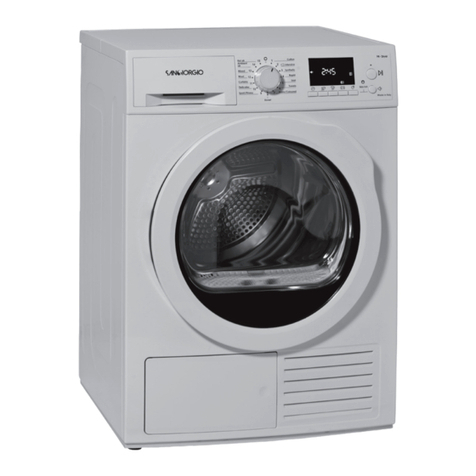
sangiorgio
sangiorgio SDR8 Use and maintenance manual
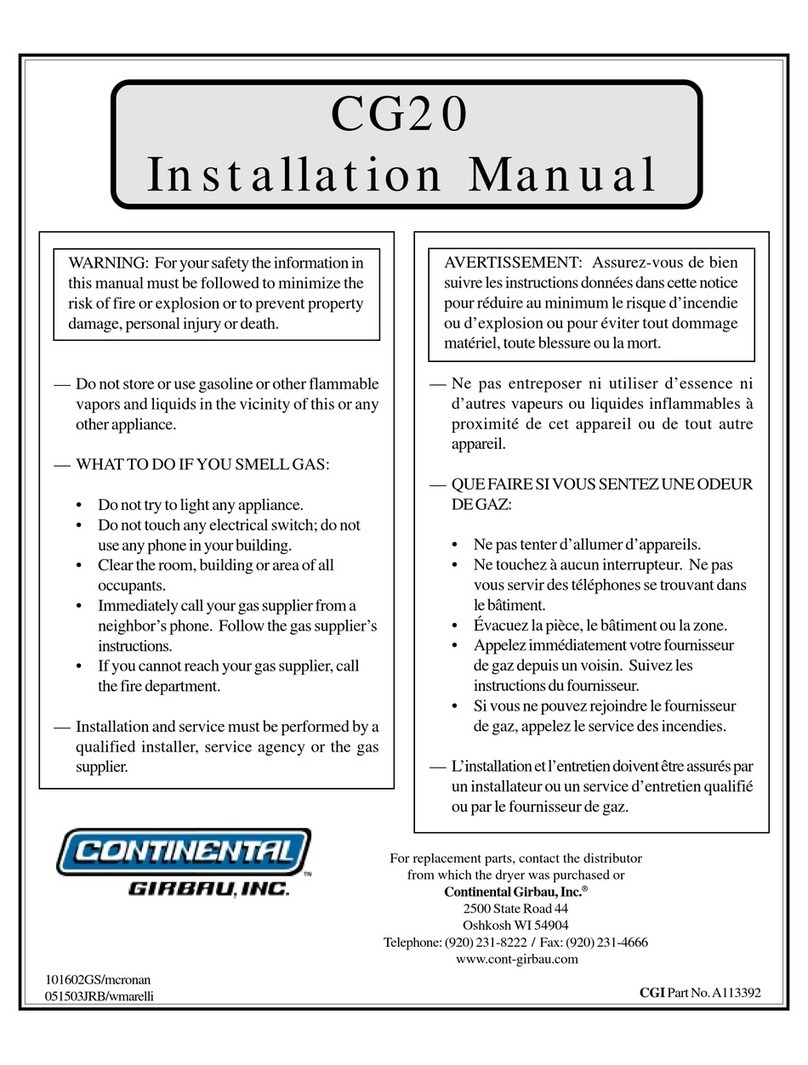
Continental Girbau
Continental Girbau CG20 installation manual
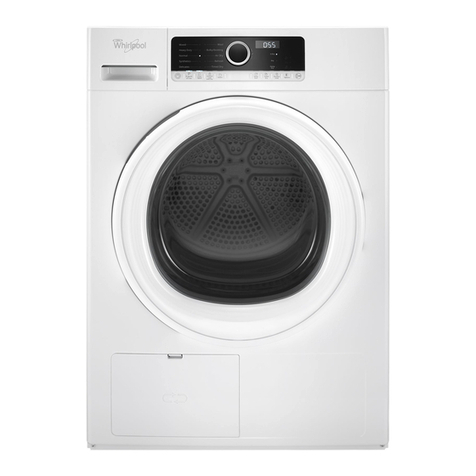
Whirlpool
Whirlpool WDH3090GW Use & care guide
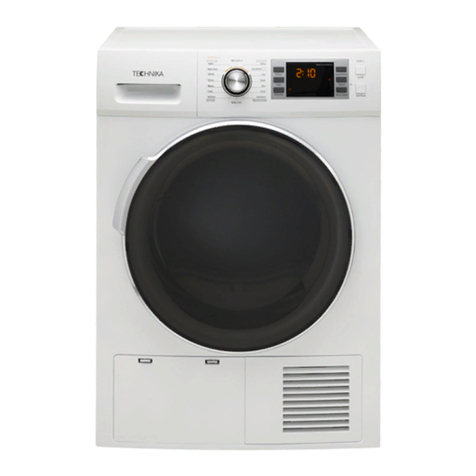
Technika
Technika TCD7E-5 Instructions for use and installation

NIMO
NIMO Easy Dryer 1900 user manual
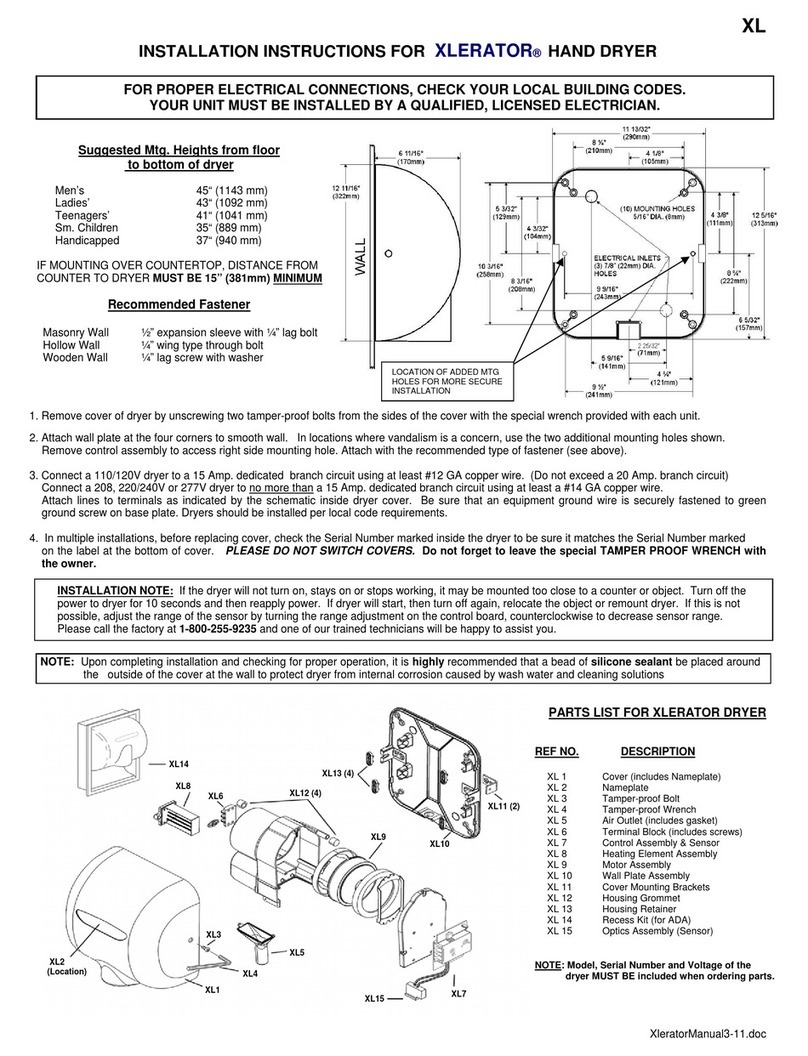
Xlerator
Xlerator XL Installation instructions manual
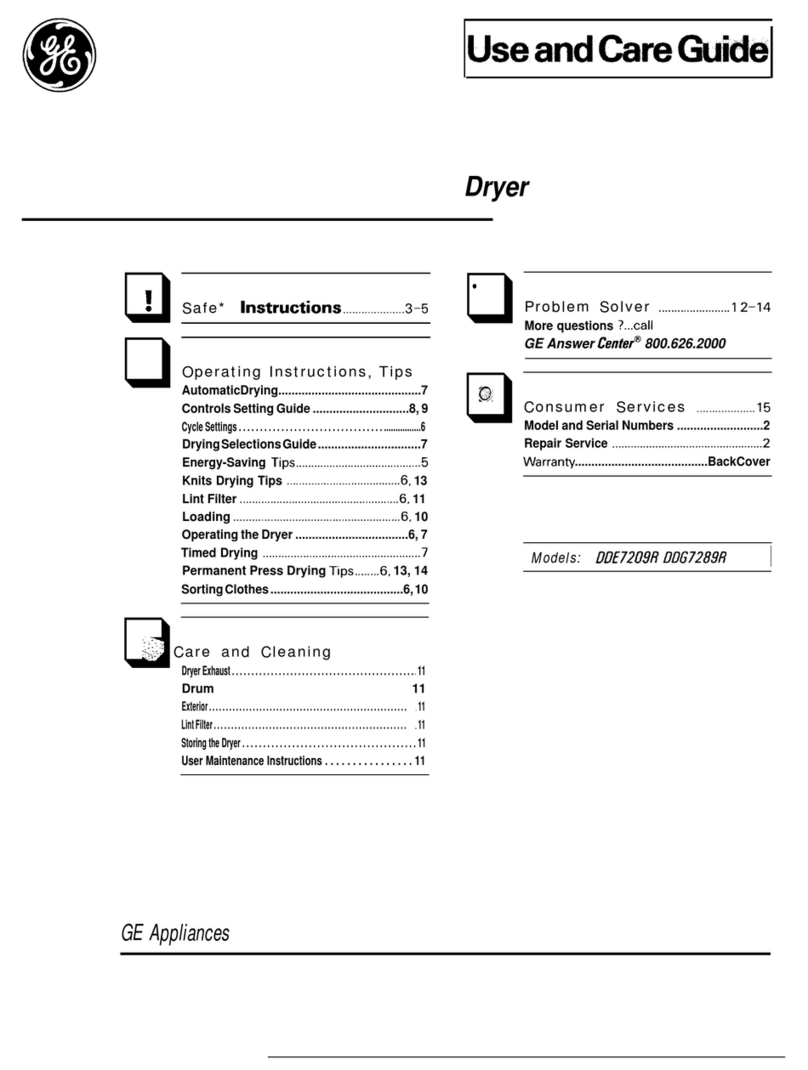
GE
GE DDE7209R Use and care guide

KitchenAid
KitchenAid KEYE860W Use and care guide
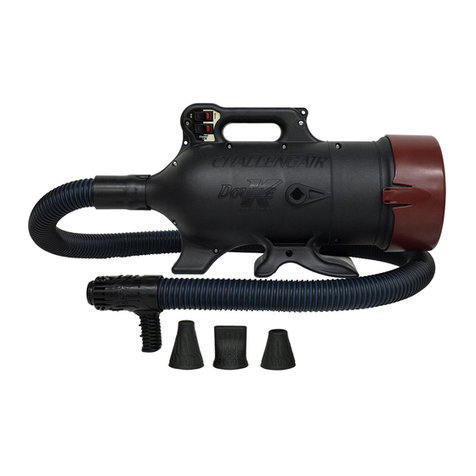
Double K Industries
Double K Industries Challengair XSTREAM instruction manual
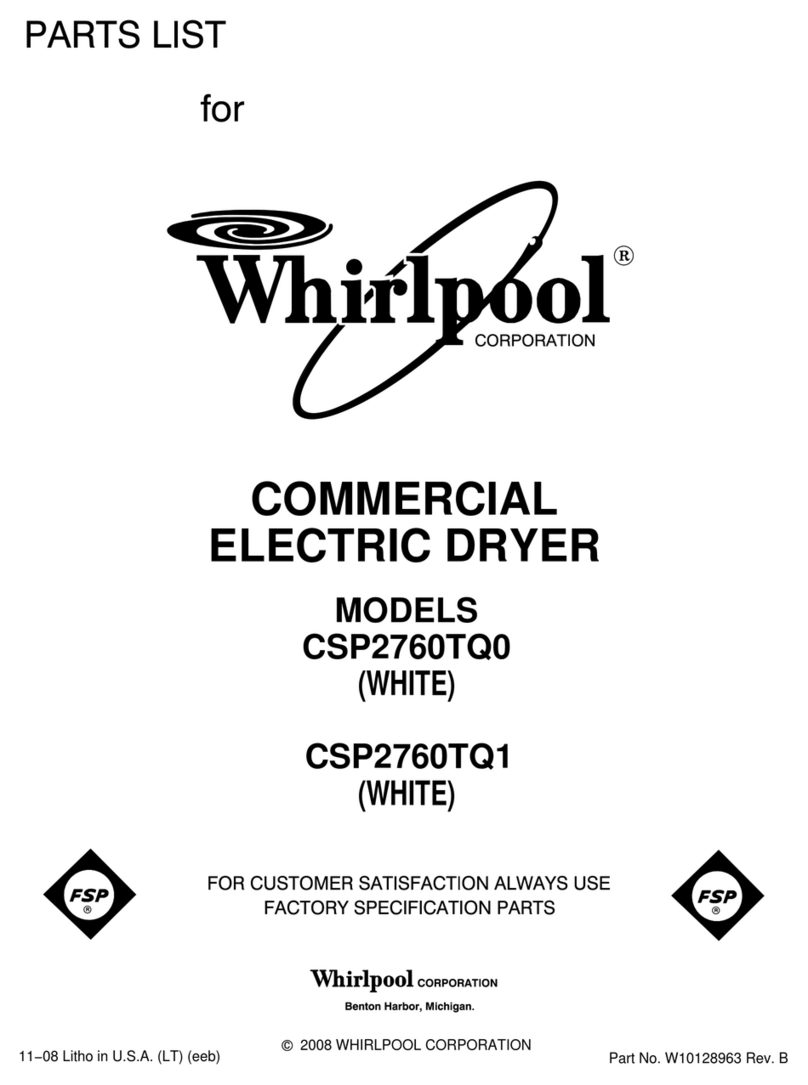
Whirlpool
Whirlpool CSP2760TQ0 parts list
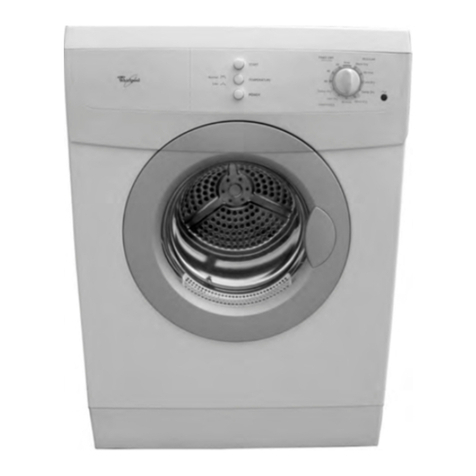
Whirlpool
Whirlpool LEW0050PQ1 cabinet parts
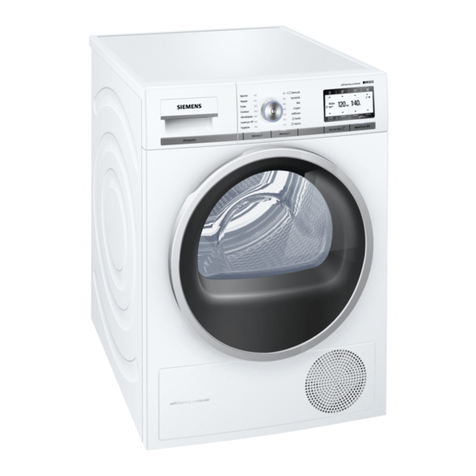
Siemens
Siemens WT4HY749DN Installation and operating instructions
